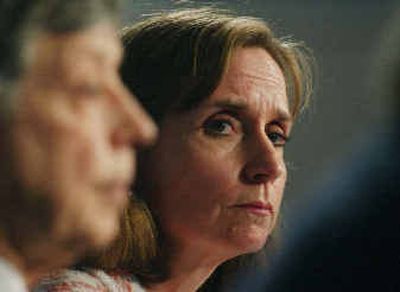States go own way on carbon control

BUENOS AIRES, Argentina – Two sets of Americans have come here to talk global warming: the United States, opposed to controls on carbon emissions, and a bloc of united states, from Maine to Delaware, that plan to impose them.
“It’s not an in-your-face thing,” Kenneth Colburn, helping coordinate the nine-state effort, said of the seeming defiance of the Bush administration. “They’re doing what they think needs to be done.”
That may even include linking up with the Europeans in a backdoor trading scheme on emissions – although a key Republican says that would meet a “lot of skepticism” in Congress.
The American by-play is taking place at the annual U.N. conference on climate change, where delegates from scores of nations are filling in last-minute details on the Kyoto Protocol, the 1997 pact that takes effect Feb. 16 requiring 30 industrial nations to reduce, by 2012, emissions of “greenhouse gases” that scientists blame for global warming.
The biggest pollutant is carbon dioxide, byproduct of fossil fuel burning by automobile engines, power plants and other industrial operations.
The United States is not among the 30. The Bush administration has rejected Kyoto, protesting that it would damage the U.S. economy and that it should also cover poorer nations, such as China and India.
But in the pyramid of powers called the U.S. federation, there were other ideas.
“The United States is states with an s,” said Fred Butler, a New Jersey public utilities commissioner here for the U.N. conference.
More than two dozen U.S. states have taken action individually to reduce carbon dioxide emissions, by ordering cuts in power-plant emissions, for example, and limiting state government purchases of fuel-inefficient sport utility vehicles.
Most significantly, California regulators last September ordered the auto industry to trim exhaust levels on cars and light trucks in the state by 25 percent before 2016. Other states may follow if California’s move survives a court challenge.
In the U.S. Northeast, New York Gov. George Pataki, a Republican, in April 2003 invited other states to develop a regional plan for “cap and trade” on power-plant emissions of carbon dioxide – a system whereby plants that don’t use up their reduced quotas of emissions can sell “offsets,” or credits, to other companies that overshoot their allowances.
Under an existing consortium, the Northeast States for Coordinated Air Use Management, eight other states joined in: Maine, New Hampshire, Vermont, Massachusetts, Rhode Island, Connecticut, New Jersey and Delaware.
Four have Republican governors, four Democratic. Combined, they account for 14 percent of U.S. carbon emissions.
A proposed design for the system is expected next April, to be considered and approved by the nine states. Colburn, executive director of the Boston-based consortium, said the states may be trading carbon emission credits in two or three years. “It’s a question of when, not if,” he said.
Although the governors want to help ease climate change, there’s a host of other environmental, health and economic motivations, Colburn said.
For one thing, New York is seeing London take the lead in “carbon trading,” which may balloon into a multibillion-dollar market. “We’re missing out on this economic opportunity,” he said.
The 25-nation European Union launches its own carbon-trading system on Jan. 1, and it has left the door open for outside participants, a possibility the U.S. states are examining.
“I don’t see why our own individual power plants couldn’t register and purchase allowances in the European system,” Colburn said.